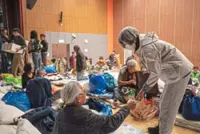One of Hana Fedora Abdul Aziz's long-term goals is to establish an academy for crafting, as she feels there is a lot of talent and potential here at home. Photo: The Star/ART CHEN
Having studied electrical engineering at a post graduate level, Hana Fedora Abdul Aziz’s ambition to go into lecturing seemed set in stone.
However, after working as an engineer for a while, she felt a desire to venture into something more creative.





